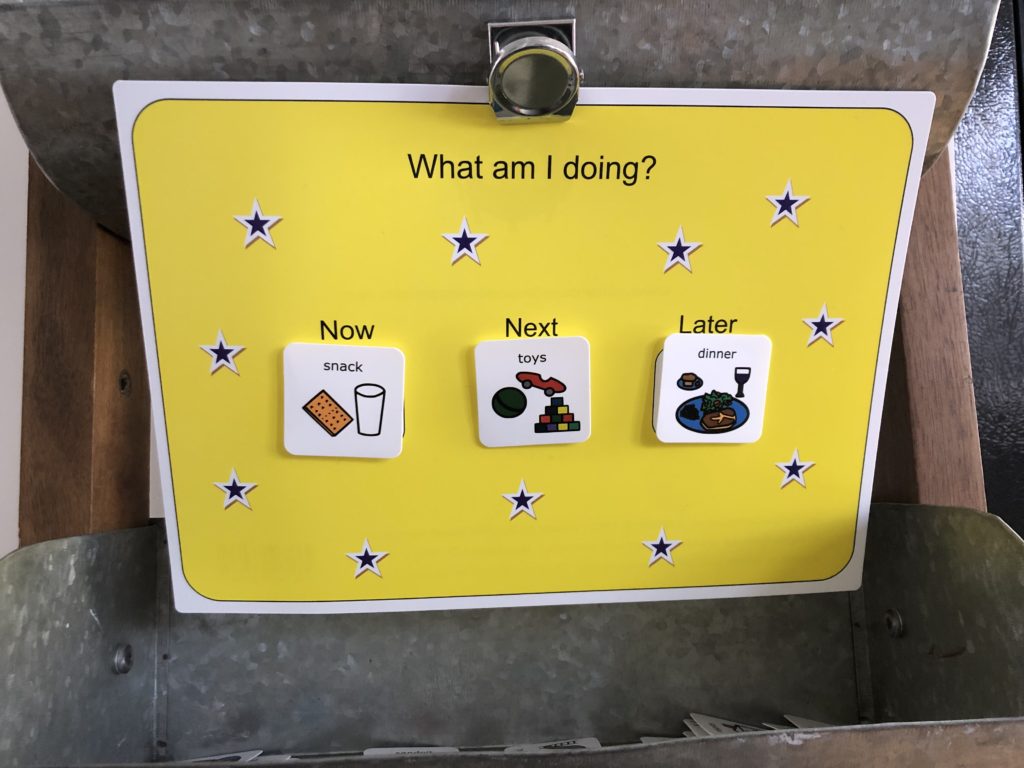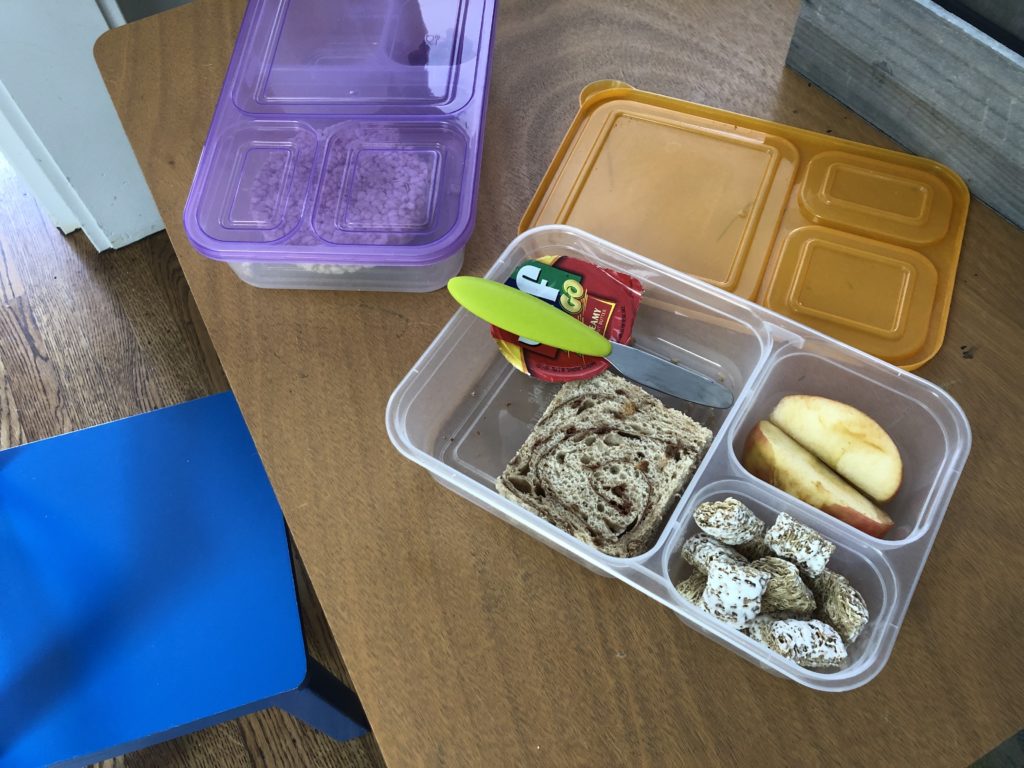We participate in Amazon’s Affiliate Program.

Hearing the phrase, “I want a snack,” makes my teeth clench and my shoulders tighten. I’m so tired of my kids saying this to me because, A) it’s not a polite way to ask, and B) they say it all the dang time. I can be in the process of cleaning the table from breakfast, and they’ll ask for a snack. Two minutes after dinner they’re telling me they’re hungry. And in between those meals, they’re foraging for food every 20 minutes. It’s a never ending battle and one that I’ve been losing for a while (I’ve previously written about my frustration and my attempt to rein in the snack requests. And there’s this compilation of memes on feeding kids and this plan of attack for my picky eater based on a feeding therapist’s recommendation.)
Now that my four- and five-year-old are in school five days a week, the snack situation is slightly more manageable. I only have to serve them, oh, approximately seven snacks between the time they get home and dinnertime. But along comes summer, with its patchwork schedule of summer camps, and my kids are back to being even bigger snackaholics.
 I’ve been reading the book Helping Your Child with Extreme Picky Eating because the food issues in my household go beyond snacking, and while I’m not ready to implement the full complement of advice that book has to offer, I’m ready to tackle snacking.
I’ve been reading the book Helping Your Child with Extreme Picky Eating because the food issues in my household go beyond snacking, and while I’m not ready to implement the full complement of advice that book has to offer, I’m ready to tackle snacking.
Snacks are obviously messing with my kids’ ability to eat proper meals, but I’ll be real with you—that’s not the primary reason I’m ready to wage war on snacks. The real reason is that I’m sick and tired of preparing snacks (or wrangling children who take it upon themselves to get their own snacks), and I’m even more tired of constantly cleaning up from snacks (or harping on children to clean up after themselves).
My new plan still takes time and effort, but it’s a more proactive approach than I’ve used in the past, and I’m hopeful this will help.
I set a daily schedule, including snacks, and show it to my kids.
Both of my kids are accustomed to having a routine when they’re at preschool and kindergarten, and by all accounts, they adapt to those schedules quite well. At home, during the summer, we also have a schedule, but the thing their teachers do well that I haven’t done is visually show my kids what’s in store for the day and stick to the plan.
At school, kids eat snack when their teachers tell them it’s snack time; it’s not on demand, as I’ve allowed at home. Kids accept this routine at school because it’s consistent, and the kids trust it will happen. So, I’ve made the following changes to my snack approach.
I’ve gotten stricter on when snacks are served.
According to Helping Your Child with Extreme Picky Eating, my children should be able to go 2.5 to 3 hours between “feeding opportunities” (a snack or meal). In between those times, if they start to get antsy for snacks, I redirect them to do something else. This isn’t easy at first and requires more focused attention on my part. Children who are used to getting snacks when they want them are not easily swayed. Over time, they’ll come around.
I allow less input on what snack is served.
The old conversation with my kids went something like this.
Kid: [in a whiny voice] I’m huuuuungry. I want a snack.
Me: What do you want? I have….. [rattles off multiple options]
Kid: I don’t know. Nothing. I want something different.
And then we’d go through trial and error before they were satisfied with their snacks. It was frustrating and a big waste of time and food. Now, I prepare their snacks in advance and don’t offer substitutions. They’re more likely to eat something when it’s simply placed in front of them—thinking in the abstract about what foods they might like to eat is not children’s strong suit. Plus, it helps me control the balance of food they’re eating for the day.
I show them when snacks will be served.
Pictures are the key to communicating with my non-reading four-year-old and early-reading five-year-old, so I ordered a schedule board on Amazon, complete with laminated pictures. I’m not artistic or crafty, so I’d rather spend $15 on a pre-made tool than create one from scratch.
I didn’t feel the need to outline every moment of my kids’ day. I just want them to have a general idea of what’s happening now, next, and later, so this board worked out perfectly. Letting them see that a snack or meal is on the horizon reduces some of the anxiety around when they’ll get to eat again.
I prepare snacks in advance.
To prevent them from foraging through cabinets themselves, I had to get ahead of their snacking. Since I’m already packing lunches for camp, I take a few extra minutes to pack snack boxes for them to eat at home when camp is over. I bought a pack of inexpensive bento boxes to rotate for snacks. This way, I always have a clean one on hand to prep with snacks, even if the kids are still eating out of another one.
Let me be clear; I detest packing lunches. The task probably takes me 10 minutes, but it somehow feels like 45, so I’m not happy about adding to my workload by pre-making snacks, but I am always grateful for those precious boxes when my kids reach for them after camp.
Before pre-making snacks, our arrival home was stressful. While I was reminding them to hang up their coats and put away their shoes, they were whining for something to eat, pulling at the door to the fridge and climbing on chairs to peek in the cabinets. They’d toss their backpacks on the counter and then push them aside or onto the ground to make room for whatever snacks they were grabbing from the pantry. It was unnecessarily chaotic.
Now, before I pick them up, I take their snack boxes out of the fridge (because God forbid they have a chill on them) and when they arrive home, they grab them excitedly to see what I’ve packed. This gives me a moment to breathe and adjust to the new frequency of a house full of kids.
The Upshot
All of what I’ve described above takes effort and planning, so I wouldn’t say that I’m necessarily saving time with this approach, but I am taking back control of my time. Being mindful to communicate our daily schedule and making snacks at a time that’s convenient for me has helped cut down on my kids’ intermittent snacking and reduced my frustration. There was definitely a transition period to our new approach but buying new snack containers and creating the visual schedule made the change feel more fun for my kids and helped them get on board with it.
Are snacks a challenge in your house? How do you handle it?




















I love the idea of pre-packed snacks! We have very similar struggles in our household, so I am excited to try this 🙂
It’s definitely been helping!!